-
Posts
1,207 -
Joined
-
Last visited
Content Type
Profiles
Forums
Gallery
Events
Posts posted by vossiewulf
-
-
On 4/26/2017 at 10:31 AM, vossiewulf said:
$19.45 delivered for 12 diamond-coated stainless steel strips, and they seem to be made well and should last quite a long time. I'm disappointed they're only on .007" steel, I was hoping for a bit stiffer. But if nothing else you can make lots of really useful semi-files out of these and that's what I intend to do.
I might pick up some of the wider 6mm strips also. BTW all manufacturers seem to sell coarse/med/fine grit but no indication of how that maps to normal diamond sharpening stones and the like.
Looping back to this subject - some time ago I received coarse grit full-diamond strips, and I put them together with the earlier Horico medium-grit strips (I hate it when companies use meaningless generic terms like that; I'm guessing the coarse is ~100 grit and the medium 320-400 grit).
I've glued them to a piece of .018" spring-temper steel. I've been using an identical tool for my planking covered in various grits of PSA, I'm going to try this version as soon as I finish the knives I'm working on.
I used this glue - anyone know about it? Besides scoring the "typo our own slogan on the bottle" achievement, as you see they claim to do better on unfriendly materials and combinations. However it seems to me to be just low-odor CA, although nowhere on the bottle or anything else I've seen have they said this is CA glue.
-
1 hour ago, donrobinson said:
Beautiful looking knives, very well done. Should i PM my mailing address to you?


Thanks Don
 If you can get to a point where you have a blade that just needs a handle, let me know ;-) It's the couple hours of icewater grinding that I'd be perfectly happy to not do again for a couple weeks. I never mind making the handles, it's a bit of precision joinery that I like. And also as you start sanding them out to final appearance you get the reward of seeing wood like this all nice and shiny for the first time, that's always fun.
25 minutes ago, Rick01 said:
If you can get to a point where you have a blade that just needs a handle, let me know ;-) It's the couple hours of icewater grinding that I'd be perfectly happy to not do again for a couple weeks. I never mind making the handles, it's a bit of precision joinery that I like. And also as you start sanding them out to final appearance you get the reward of seeing wood like this all nice and shiny for the first time, that's always fun.
25 minutes ago, Rick01 said:I've actually used a makeup brush for a few years now and love the way it lays paint/varnish down. Love the knives but wonder - have you thought/experimented with a slight curve on the tail like this http://www.thewritingpenstore.com/p-1356-stabilo-easyoriginal-rollerball-pen-left-handed.aspx. I use one of these pens as a leftie and find that it helps anchor it quite securely.
It's OK I think I can still remember some of the mods I made to the kit!

I've used them before, I agree it works but this is where form goes up against function for me and form wins
 And if you hold these the way I do, it really can't get much more stable. BTW these knives are ambidextrous, I find myself using my left hand to do things often enough these days that I decided to make them left-friendly too.
And if you hold these the way I do, it really can't get much more stable. BTW these knives are ambidextrous, I find myself using my left hand to do things often enough these days that I decided to make them left-friendly too.
-
First, india ink vs. Faber-Castell Pitt pens.
One of these is india ink and the other is the Pitt pen. Looks identical right?
Now let's change the orientation a bit so we're not getting direct specular reflections and we just see what their ambient color is.
Not quite so identical. The one on the left is india ink, and has as close as we get to a pure black ambient color, while the Pitt pen is dark grey. And this is not surprising when you think about it, I'm sure the ink in the Pitt pens started with a foundation of india ink, but pen inks are highly engineered substances at this point- they probably added flow enhancers and drying retarders and who knows what else to give the pens a long life and proper function.
And if you have something that's pure black and you do anything to it other than add more pure black, it's going to change it to a grey color. So I'm going to hang onto these pens, but probably use them the same way Popeye does - for small areas and deck plank caulking.
I experimented with using makeup application sponge brushes applying india ink last night, and it worked extremely well. In fact I'm wondering why I don't use these for any non-laquer finish, there are no brush marks and it can carry more paint without dumping it all in one spot, only smoother way to apply something is by airbrush.
This "brush" is what I was experimenting with.

However I also bought these, much cheaper and a long term supply, haven't tried them yet but see no reason why they won't work fine. I'll just cut them in half and stick them on a dowel to use.
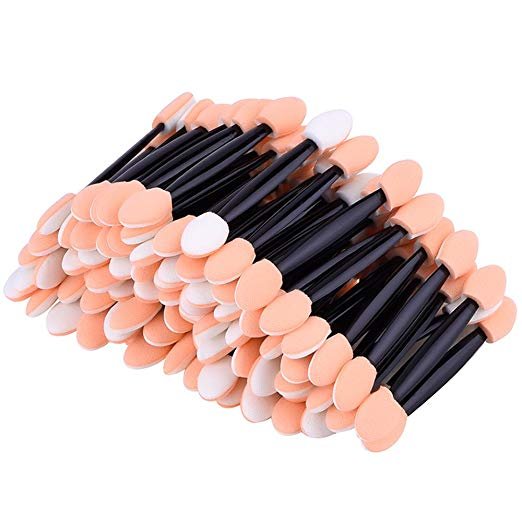
While I was at it I also bought this, not for brushes, but as liquid application/cleanup swabs, was a shot in the dark but turned out to be a good choice - these are a good size and the swab material stood up to some pretty heavy scrubbing (I used one with some acetone to clean out tape gunk from one of my new knives). As in it wasn't damaged at all and was ready for scrubbing round 2. They also have a strong plastic piece inside the swab as reinforcement, which really helps if you're using swabs for cleanup. And best of all, ZERO lint.
Anyway, for 6 cents a piece this seems a good purchase.
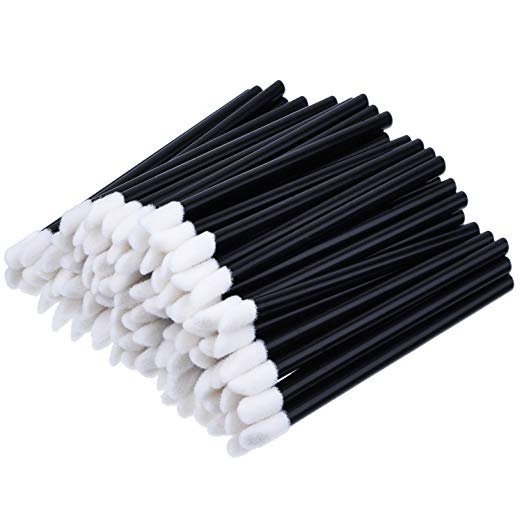
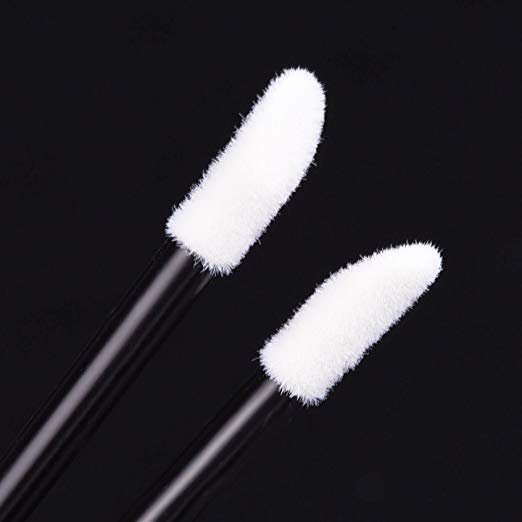
Now back to the knives - don't worry Rick, we're almost done

First, another tip - this applies to cleaning up any surface actually, but is REALLY important shaping something roundish like these handles: you want to be positioned under good light, but at a very oblique angle. This enhances the surface detail and makes it much easier to see the bumps and recesses that you need to see to produce a smooth final result. In fact if you don't get yourself under light like this, you might as well close your eyes and go with touch as your main sensor to tell you where you need to sand and where to stop, because direct light hides all this information from you.
Along in here I also crosscut them to their final length. This pic should explain why

And here is my new grip type, I'm going to call it a dromedary handle. Test-driving strongly suggests it has some advantages control-wise over the pregnant snake design. That works very well also, but I think the dromedary might be the superior of the two, will see if that holds true once we get some real cutting miles under the dromedary knife tread, to horribly mix several metaphors.
Also, it should be obvious that an important part of the reason to make non-round handles like this is so they stay where I put them on my bench. No rolling for you, Tom and Jerry planking knives.
This is also the point at which we stop with the power tools and from here it's all hand-sanding. As Popeye would say, there are a couple of knives in there and we're getting pretty close to finding them

We want to go slow here and be quite careful about what we are doing, it would be painful to screw them up at this point. So we work our way through the grits, regularly comparing the two and using our oblique light to help us get nice smooth continuous curves with a round (from end-on) tail.
And we look very carefully for those little scratches that like to hide until we have our CA finish on when it's a major pain to fix, see the spot I'm pointing to. The transverse scratch near the end won't come out, that is where the burl snapped in handling early on. I'm hoping that the CA finish hides it to some degree.
I won't mention how high we go in grit, because Popeye, who is guest-starring in tonight's episode, would have his eyeballs emulate his handle and pop out and do a full 360 before popping back in. All I can say is those who say there's no advantage to sanding to a high grit are somewhat less than 100% correct
 IMO it makes a very significant and positive difference in the appearance of wood to have the fibers be cut as cleanly as possible. On holly, with nearly invisible grain, it is in fact probably not worth it - there's no grain to show to advantage. But if the wood has a dramatic coloring or grain pattern, it will be considerably enhanced by sanding out to Popeye eye-popping numbers.
IMO it makes a very significant and positive difference in the appearance of wood to have the fibers be cut as cleanly as possible. On holly, with nearly invisible grain, it is in fact probably not worth it - there's no grain to show to advantage. But if the wood has a dramatic coloring or grain pattern, it will be considerably enhanced by sanding out to Popeye eye-popping numbers.
Just need to drill out the tails for their brass balance pieces and they can go in their thin CA bath to start the finishing process. Here is where I do wish they were round - round handles can be chucked in the lathe and then the CA coats can be applied with a pad while moving down the spinning piece, leaving a nice smooth base for final sanding. Without that, getting a level CA finish on the whole handle takes a while and a goodly pile of sandpaper.
- popeye the sailor, Canute, hexnut and 2 others
-
 5
5
-
That's all standard 3d printing stuff, there are multiple packages designed specifically to set up a model for 3d printing with the appropriate supports and orientation and they check minimum feature size. The latter you have to check and know before you begin modeling, you can't just model whatever and expect it to 3d print at any scale. You have to plan for and create different versions of your models at various scales as the minimum feature size shrinks relative to the size of the model as you go up in scale.
None of them are insurmountable, but it's also something unlikely to be navigated by someone who is not a very experienced modeler. Once I get my desktop up and running again I plan to work on printing some of my work through Shapeways and maybe offering some models useful to people here and in other (physical) modeling areas, I'll let folks know what I learn.
- thibaultron, mtaylor, Canute and 2 others
-
 5
5
-
-
2 hours ago, shipmodel said:
That knife is looking good! Maybe you can go on "Forged In Fire - The Miniature Show".
I experimented with your pencil grip and found that even using a generic hobby handle armed with a #11 blade I could get clean, well-controlled cuts through thin sheetwoods of several species. Thanks for showing it.
Dan
Great! Am honestly very happy anytime my experimentation and efforts can be be used by and help other people who perhaps don't have some of the opportunities I do to try all this stuff out.
-
Short update, work and other issues have kept me awake and busy for almost all of the last three days.
Picking up where we left off, I de-clamped the two knives and then spent the next 30 minutes on the Byrnes disc sander leveling and squaring the blade-side vertical face with the two sides.
Using my big straightedge to check that the faces are flat and straight. Not really required, it's just a handle, but if I go to this effort I like to make sure it's exactly what I intended.
And then we redraw the outlines of the final handle shapes and it's ready to dance on the scroll saw with an 8tpi/6R blade. I've forgotten what the 6 means but the R means the blade teeth pattern reverse below the cut.
Finally looking sorta like a knife!
When it comes to shaping handle, I grabbed several choices, never quite sure which will work the best.
I ended up using the carbide single-cut bur. This is my sophisticated rotary-tool carving setup where I take my Festool dust extractor intake and tape it to my bench. Place it between you and what you're rotary carving and almost all the dust will go down the vacuum. If I'm working on something small I'll put a mesh over the end of the vac tube.
However after doing the initial bevels I wasn't happy as even the nice sharp carbide bit was causing some minor tearing of the grain, which I didn't anticipate since the burl planed so well but there it is. So I had to switch to straight abrasives.
And I decided I wanted to do a slightly different grip from my normal "pregnant snake" handle pattern, so I quickly made one out of balsa to test before committing to the real handles.
And here a little test-driving. Whenever I catch up on sleep and I get a chance to work on them again I hope to get to the initial finish stage, which will be soaking the handles in thin CA.
-
On 6/4/2017 at 9:43 PM, BANYAN said:
Thanks Jay, appreciate the feedback. I have a Japanese marking knife (single bevel - right) that I picked up at a woodworking show here. It has a fitted handle but I may try and take it off.
Wood I guess on the handle? Because the usual is rattan wrapping and that takes zero time to remove. I've seen some with wood handles similar in shape to their sword grips, fairly large handle that is elliptical from the top view but straight from the side view. It should be easy to remove, the handles of Japanese tools are considered temporary, to be replaced whenever needed/wanted.
-
1 hour ago, gjdale said:
Jay - you're killing me! Stop feeding my addiction. No don't stop. Yes, please stop, No, don't stop...........................
Although there are larger more expensive sets, in this case you should be completely covered by a 9 piece $15 Swiss set that is .9mm - 2.3mm. So this is more of a minor flesh wound

However since they're only $3-$5, I'd also add a couple bigger ones between 4mm and 10mm so you can rapidly finish even 1/4" ends

-
Steps of the build where you have to fit and trim the same pieces a zillion times can be very tedious, or at least I think so. So I might need to take a couple of days of BTO (Build Time Off) while you finish this part. I'm pretty sure I've accrued enough days, last time I checked my contract says I get 20 days of BTO per year plus all the standard holidays- navy day, national wood day, the festival of St. Redleaf, patron saint of oaks, etc.
- mtaylor, allanyed and Richard Griffith
-
 3
3
-
Today's episode of Tools You Need That You Didn't Know You Needed....
CUP BURS! Here's a quick description of their "official" purpose, that of deburring, rounding, and finishing soft wire ends in jewelry. However, they work just as well on wood dowels, carbon fiber, plastic, polycarbonate, pretty much anything but hardened steel piano wire. And for that, you can find cup-shaped grinding burs in many types of grit.
Standard cutting-type cup burs look like this, this is on a 3/32" shank, I don't think I've seen them on 1/8" shanks but they probably exist for larger sizes.
Here I will demonstrate with a piece of (I think) .035" carbon fiber rod. I've intentionally cut it leaving a sloppy bad edge.
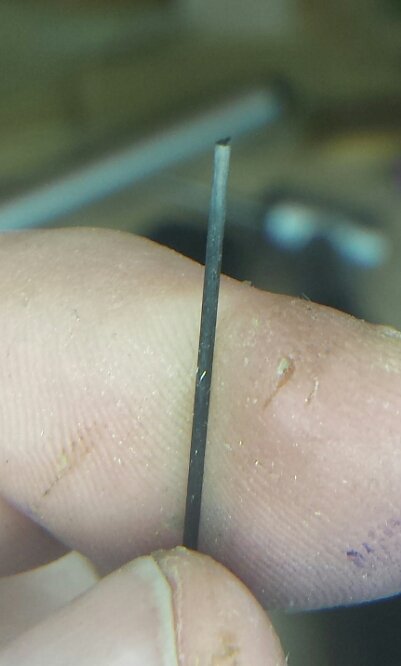
Hit it for like half a second with the cup bur though, and now it looks like this.
Square, clean, with a lightly beveled edge. Perfect!
Of course you can also do this with sandpaper or files, but nowhere near as consistently and ten times slower, at least. If you're cutting a wire or a dowel once a week you don't need cup burs, files and sandpaper will handle that.
However, if you have eleventy thousand treenail ends to prep for insertion or you're cutting lots of wires, go get yourself a cup bur or two. Best results are with a bur only slightly larger than the work piece but in my experience you can get by with just two or three sizes, buy a set of 8 if you want full coverage, or just one that's a bit larger than the largest size wire/dowel you typically work with and make do, it will still work much better than sandpaper and files.
-
Also FYI I edited the knife process post above to add info about marking with machinists' dye and why you want to use brad points and not pilot point drill bits in wood, and added some text formatting that hopefully helps with readability. Probably not of much use to the people replying here, it's there for the less experienced people.
Also also FYI, I edited this post to add more information about the more information that I added to the other post I edited.
-
-
Very nice and straight and aligned, that's a very good start, looking around its surprising how little attention some people put to this crucial step. Making sure everything is aligned right at the beginning means everything else will go on without any gymnastics.
- maddog33, Nirvana, Tigersteve and 1 other
-
 4
4
-
6 hours ago, shipmodel said:
What an excellent discussion of your process. I may never make a knife, or its handle, but the story of your perseverence is inspiring, whatever the subject.
Hope your wound is recovering nicely.
Dan
Oh it was just a 1/16" little hole in my fingertip, but with the fineness of the points that was reasonably deep and so at the time it was dripping all over but 30 seconds of pressure and a bit of superglue and it was all fixed.
You should try your hand at it some time, making things with tools you made yourself is particularly rewarding, or at least I think so.
- Canute and popeye the sailor
-
 2
2
-
7 hours ago, popeye the sailor said:
back to the archive pen you showed. i use the same pen for my simulated calking. if your going to use it on a large scale, I would suggest buying a bottle of India Ink, and do a wipe on process. it's the same ink that is in the pens

You're probably right. I've been discussing it with wefalk in another thread, and ordered some eye shadow application sponge makeup brushes and am going to try that to apply India ink. We'll see how that works.
- popeye the sailor and Canute
-
 2
2
-
I'm sure I'm understating a little when I say that must be frustrating. And odd, here shipping costs worldwide have become so low that I order from all over, only rarely do I see shipping costs that make a purchase not worthwhile. That's a huge disparity and I don't know why it would be so different.
So we have everything ready to go, clamping pads and all the clamps laid out and set to require just a half turn to tighten, epoxy and mixing sticks, nice and orderly like it should be before gluing up something like this. Note that this is not something for spring clamps. Something that will be stressed like a knife needs totally reliable glue joints and that means epoxy and serious squishing pressure.
So everything goes smoothly right?
Yeah, not so much.
I should be using nice slow 60 minute epoxy but didn't have any on hand and I was too impatient to wait, figuring I'm a super cool knife making kind of guy and it'll be fine. But it makes you move fast and that's never a good thing with knives. Second, I had an oversight as to how these are different from other knives I've made. In those cases, you make the handles slightly too wide for obvious reasons, and therefore the brass pins which go all the way through in those cases can be slightly recessed, and clamping is straightforward. Because the pins on these knives are only on one side, I had left them long. And I didn't want to cut them down at that point because there is no extra width on the handles, the piece of amboyna burl I had was just barely enough.
So I get glue on and the knife assembled and reach for the clamping pad, a piece of basswood same size as the handle, and #%#^$#$^ well that won't work, great, ok remove the one on that side and then just use one but wait while thrashing with moving it around let's stab our finger reeeel good on the super sharp point and start dripping blood all over. Well that's just oodles of help. Dealing with that the other clamping pad fell off the bench and I said screw it and just clamped straight on the handles. That won't make the no extra material problem any easier.
So anyway here's the process with the other knife, which went slightly better.
I'm using this precision Dremel router base to do the rabbets. You could do it on a mill or even a drill press considering you're taking off .040" on each side. I decided to use this as I bought it to do inlay but haven't done any with it yet so wanted to fiddle around with it and figure it out. It works fine, it's a bit fiddly but you can control depth down to thousandths of an inch without too much difficulty and I managed to keep it stable on these narrow handles, although the size of the Dremel didn't help. Being used to micromotors it's like having some finish nails to tap in and someone hands you a giant cartoon hammer. They've actually gotten bulkier AND louder, that's some fine rotary tool engineering there, Lou.
Look at the Otto Frei basic micromotor kit. At $180 it's not much more than one of the big Dremel packages. Sigh. Actually not sure that's a good idea, it's not even brushless. The Marathon is probably the best entry level choice but it's $330 for the kit, hardly a minor investment.
Demonstration of the point. Besides the size, the other huge advantages are they are an order of magnitude quieter with a similar reduction in vibration.
Here I am testing the depth. BTW, Important Point, this is not a plunge router it's an inlay router. That means for best results the depth of cut shouldn't be more than half the bit diameter and you should be going at max RPM for the Dremel.
For those who've never done something like this, you first remove the waste, not coming too near the edges, leave no more than half the bit's diameter. Then go back with the bit not working nearly as hard which means you don't have to push as hard, and therefore it's easy to trim right up to the edges. Another Important Point is to always cut against the rotation of the bit. The other way is called climb cutting and it is not good for accuracy.
And we end up with something like this.
Just need to clean out corners and trim the lines just a bit.
And it's fitting to use him to make his new home.
And we end up with this.
And looks good depth-wise.
Next I made this, because another thing that didn't go well on the first knife was the front brass pin hole was quite a bit off. It's much easier when the holes go through the blade, I had tried to just measure positions and got the back one exactly right but was off on the front one by more than 1/64", it will require fixing. So that wasn't accurate enough.
Any guesses?
I then cut it off at the line you see above, and needed to file the cut line flat.
This is my hand vise, it's as the Brits say a bog-standard set of draw tongs for pulling wire through drawplates. I love the tightening mechanism, because of the cam curve you have very fine control of the pressure, although I'm not sure why considering draw tongs only need one pressure, mega-squish, but there ya go. They have a very smooth action and very fine control and can smoosh the hell out of something if you want to. And they are hefty steel, nothing flimsy here.
Only thing I did was epoxy leather on either side, looking pretty worn out, need to replace them. Oh and they were like $15-$20 at Otto Frei I think.
It was so I could use the brass piece to do this- mark the two rings that are blue outlines.
The blue is another good trick, I use machinist's layout dye, it comes in blue and red and they are both full-nuclear stainers. Don't get it on anything you don't want it on, only metal will survive un-blue, they are lacquers and come off metal easily with lacquer thinner. On cloth thinner just spreads it.
For wood though, you can do this with any marker, although you don't want to use anything that penetrates deeply.
Machinists swab it on a surface - it dries in seconds - and then use a hardened scribe to draw lines, the bright metal contrasts extremely well with both the blue and red dyes and good scribes cut very very fine lines.
On wood I do the exact opposite, I wiped it on, used my little brass piece as described below to punch the circles in the two correct spots, and then I sand off the dye. It's unlikely you will lose more than .001" to do this, as long as you're reasonable and use 220 or 320 grit. And it doesn't need to be perfect or complete, as you can see with just a bit of sanding what you end up with are perfect little thin-line circles that make it extremely easy to center your bit.
Also, if you're drilling wood, use the correct bits that are carefully engineered to cut the best and cleanest holes in wood - brad point bits. Pilot point drill bits are specifically designed to cut metal. They'll drill wood of course, but require a center punch to keep them from wandering, tearout more, and generally cut much less clean and very un-round holes than brad points. Buying a set is a one-time purchase, ship modelers don't drill anywhere close to enough holes to dull them. Well except for member Gaetan maybe, the size he uses for treenails probably has been replaced once or fourteen times.
That's the one disadvantage of brad points, good luck resharpening them, whereas pilot points are pretty easy to sharpen. Dull brad points get recycled or made into something else.
The center point will not wander, is easy to locate, and the side spurs cleanly sever the wood fibers at the edge of the hole before the drill edges proper remove the waste.
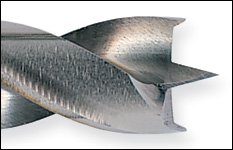
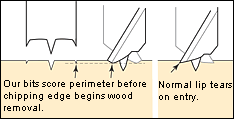
So my little brass piece is a transfer punch, used to copy a hole's location to another piece to be drilled. The ones you can buy transfer the center point of the hole; since making that kind required firing up the mini-lathe I opted for the inverse, and have it transfer the full circle.
Here's how I did it although this is post facto as you can see I've already drilled the resulting holes. It is just tall enough to make the mark but short enough that I could assemble that side of the handle with the blade to ensure correct positioning. I then rapped it a few times with a small chasing hammer.
And this time thankfully it was perfect, dead on.
It looks like something from John Carpenter's The Thing. But this time all went smoothly. A measure of the clamping pressure is that on most of the clamps the basswood is crushed down to less than 1/32". As long as you're not damaging the wood of the handle there's no such thing as too much clamping pressure here.
-
This knife from that site is 20cm. Since you only need about 5cm for a knife you might get 4 out of that $30AUD, at least three. But they'd all be single bevel. I'd make skew like mine left and right and two more with a skew angle of only 20 degrees or so, that geometry is really good for cleaning out corners of things. That's what I'm going to do with the other two pieces I have.
BTW, don't buy a Japanese pocket knife if you ever let anyone else especially children use it. For reasons not clear to me even their pocket knives are insanely sharp Rc63 steel.
-
Oh yeah I've used Japanese marking knives before, many (many) years ago when I spent five years as a custom furniture maker before going back and finishing school, so I knew any reasonable one is going to be typical Japanese quality and Rc63/64. There is no people with greater obsession about steel and sharp steel implements as the Japanese, so there really is no such thing as poor steel from any reputable seller, they range from really good to amazing.
Also the only western knives I use are from Ron Hock, the rest are all Japanese and much like the above were not terribly expensive, I buy them as kind of raw kits and then finish them into something much better. The $25 or so Japanese knives from Japan Woodworker that I posted in my tools thread and above I think are also good examples. Regrind blade, take handle to mill and mill half of each side off, glue on $2 of fancy wood, shape it like you want it and then finish it in solid CA glue. Almost all my tool handles get that finish because it provides really excellent grip, the shinier it gets the better the grip gets, and it's almost bulletproof. Look at my wenge knife that's been rolling around on my bench for at least a year since I last shined it up a little and it almost looks new.
Back to marking knives and steel tools in general, in an intelligent approach to lowering costs, generally the mid-cost tools will still have very good steel, but not nearly as perfect preparation; you saw there was a fair amount of work to get the backs and bevels on these flat, if I'd spent another $25 on them there would have nothing required but the steel wouldn't be any better. So if you have a bench grinder and a good array of sharpening tools and a willingness to spend two or three evenings working on knives, you can make yourself beautiful knives that will last forever and do exactly what you want them to do really well for maybe $15 in blade and wood.
Remember that Japan Woodworker sells them in "western pattern" double-bevel style with the good steel in the center. You will want to get those unless you want single bevel like mine.
The reason the standard versions are left/right single bevel and made to be extremely sharp is these make not just a "mark", but their cut is the actual visible edge of the joint (in traditional joinery at least), and considering that Japanese woodworkers are pathological about perfection, that means those knives have to be very sharp. And to ensure that perfection, they are single bevel and in pairs so no matter which side of the ruler you're cutting on, the cut is dead on that ruler edge, straight and perfectly perpendicular to the wood's surface.
-
Thanks wefalk. It seemed likely they'd use what they called lamp black and we call carbon black today with buckyballs and nanotubes and graphene.
I ordered some eye-shadow application sponge brushes for makeup yesterday, I think those might make good india ink applicators, and I guess am going to continue to experiment. I'm still a ways from needing to make a decision. But the Faber-Castell pens are pretty black, people should really consider having a couple on hand for very small areas or hard to reach spots at least, they're an order of magnitude easier to use than anything involving a brush and the ink should last fine.
-
I had forgotten about artist's markers. These are acid-free archival ink and should last at least as long as paint and I very much like the thinness of the coating- much much more in-scale than any paint or finish we typically use.
This isn't quite as black as india ink, but would be super-easy to do.
BTW, what was the contemporary black pigment? If they used carbon black like india ink then that would be the accurate choice, as wefalk said, india ink doesn't fade.
-
Trying to finish the knives, included here for those interested in the process. I don't think it's particularly difficult if you have a bench grinder and a drill press, but grinding already hardened and tempered steel without damaging the temper is not a super-swift process. I make it go as fast as possible by using icewater, cool the blade way down between grinding passes, that way you can get in more before it has to go back into the water.
Also always try to hold it up near the cutting edge, that way you know for certain when it's time for it to go back in the icewater bath.
First we don't need all that length in the handle, so I cut them in half with a larger cut-off wheel in my rotary tool. This process is more about good cut-off wheel and linear speed of said wheel's edge than it is about torque, Dremel tool could easily do this too. Since the linear speed makes a difference, a larger cut-off wheel like this helps, especially as cut-off wheels are usually restricted to 15k RPM or less.
And now we have two for the price of one, and those $22 knives are now $11. I already know what I'm going to grind these new blanks into, but not right away. They got waxed and tossed in my knife drawer.
As mentioned this side of the knives is very low-carbon steel and is barely hard, and therefore files easily. This is just establishing a flat to help with the grinding.
There was no way I was going to be able to drill through Rc64 hardened tool steel, but I still want mechanical blade retention, although these will be light duty knives you never know, and I never make anything flimsy. So I took a 1/8" end mill and made holes as deep as I could, which was basically zip through the low-carbon steel and then hit a solid wall of the bottom Rc64 strip. I will glue in brass rods that will pass through one side of the handle.
I definitely totally meant to have one with a 3/4" separation and the other 1", that's my story and I'm sticking to it.
I then took them to bench grinder and narrowed them down and made the top and bottom edges parallel. I also ground in a notch as you see here so the wood of the handle will also be mechanically resisting the torsion stresses of cutting.
And here we are cutting the rabbets, blade is fitted into its rabbet on one side. This is best done with a mill, but also can be done with a drill press set up for milling, a small router, or a Dremel with a router base. I used the latter here.
I should be able to glue them up and mostly finish them tomorrow.
- hexnut, Rick01, popeye the sailor and 3 others
-
 6
6
-
Planking in particular looks great and that is not an easy hull to plank. What are the plans for finish/paint? One thing I'd suggest is filling the grain, this wood has a pretty open grain structure for this scale, two or three sanding sealer coats would do it.
-



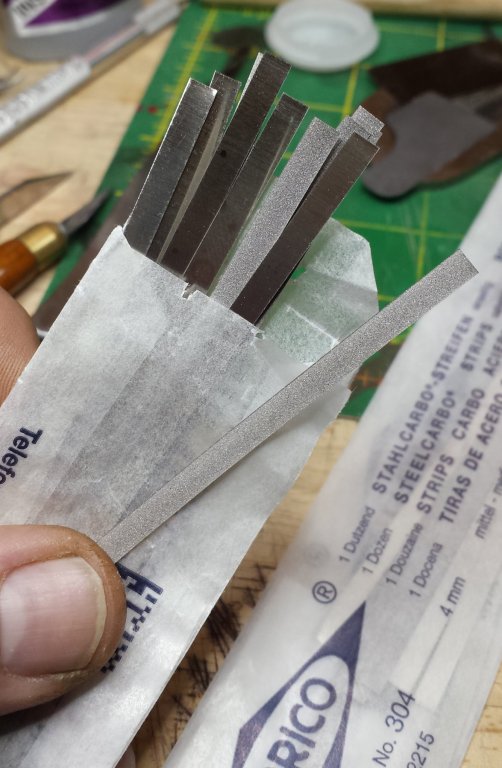
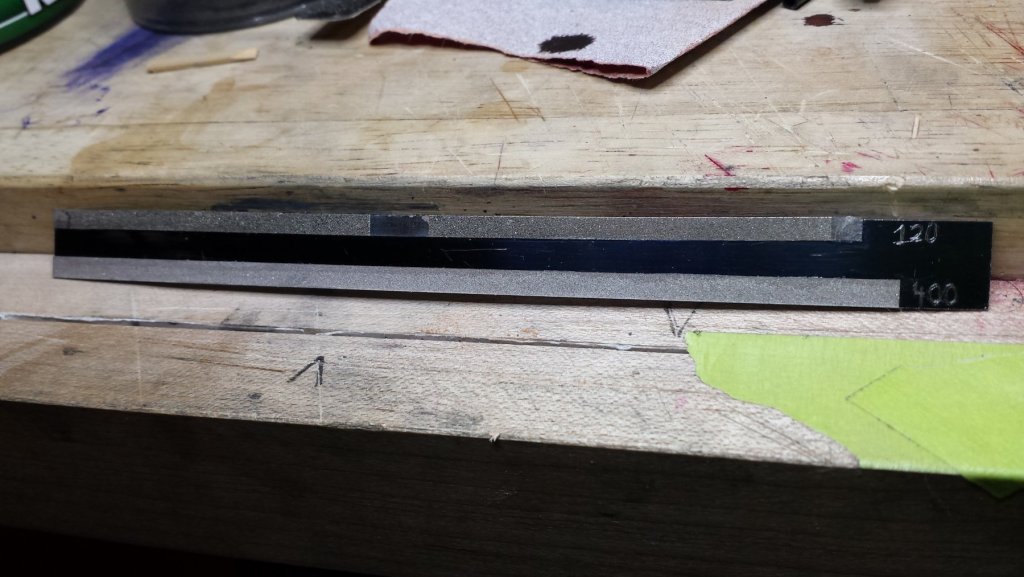
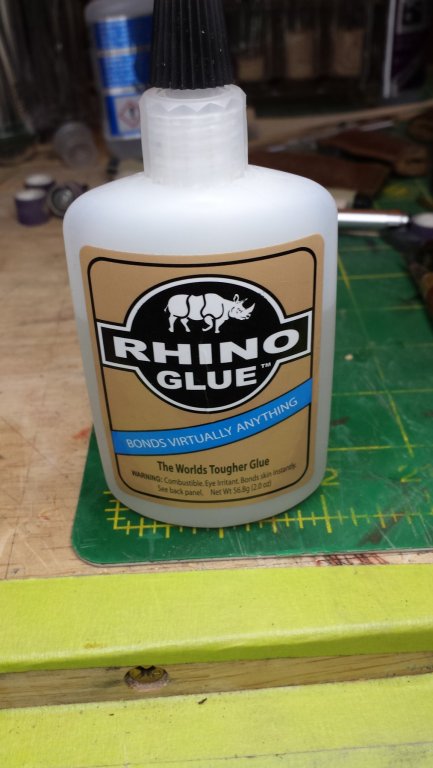
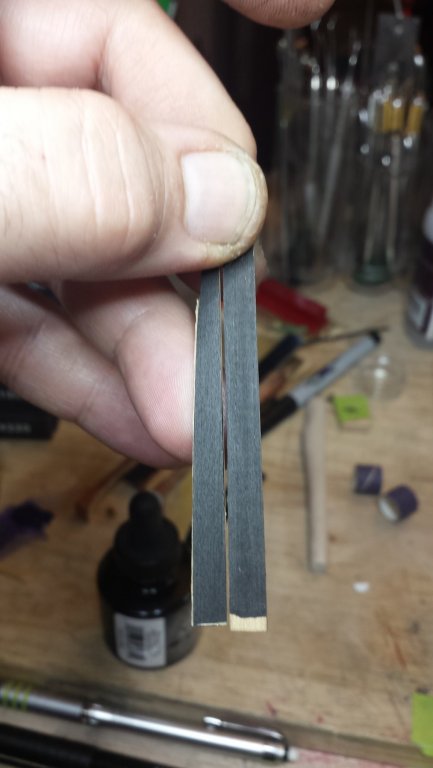
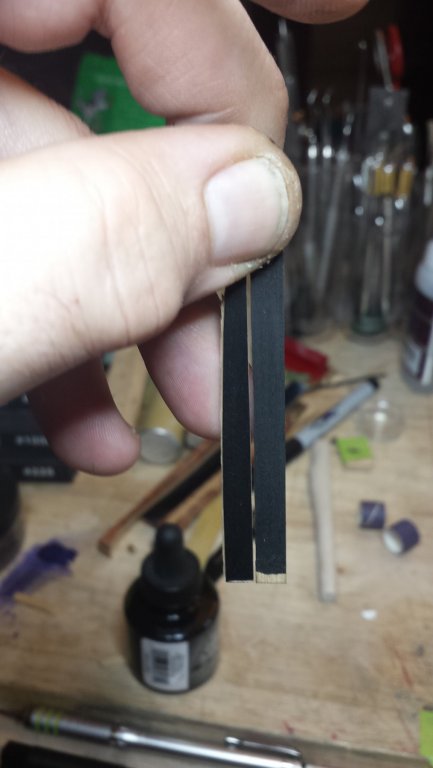
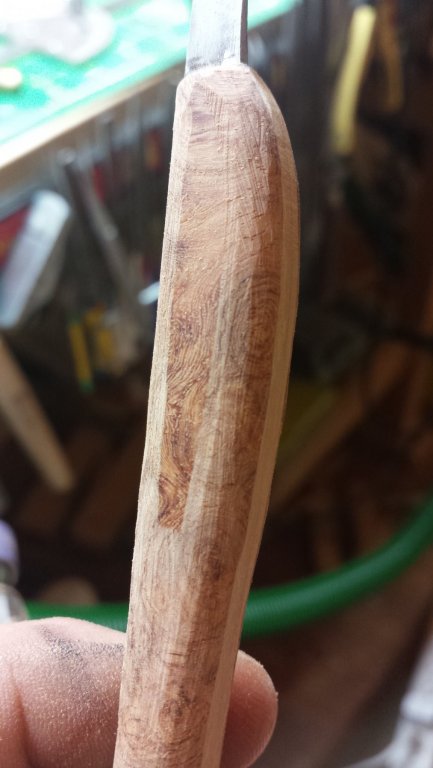
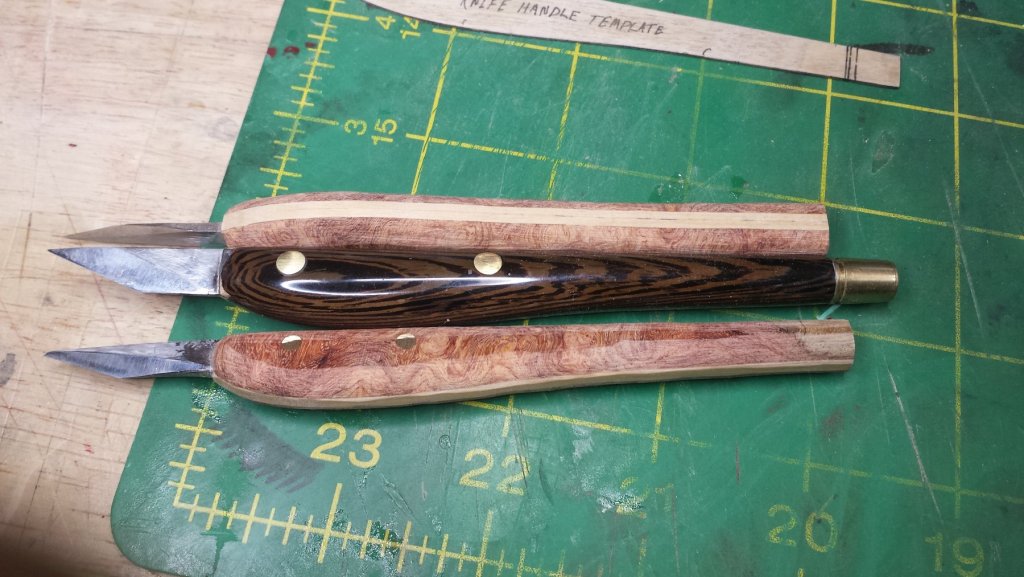
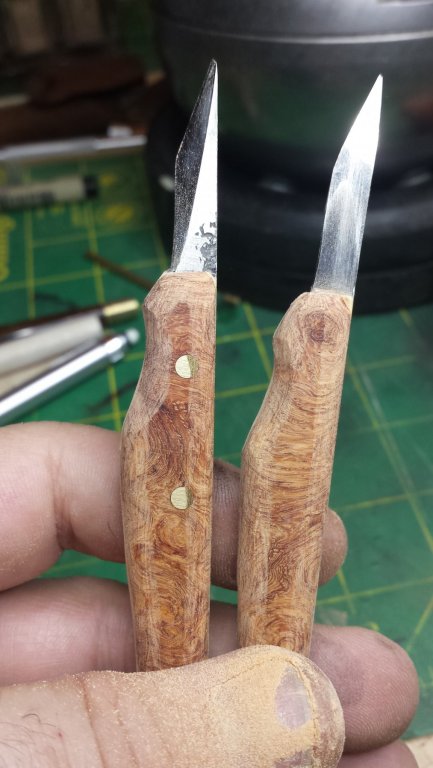
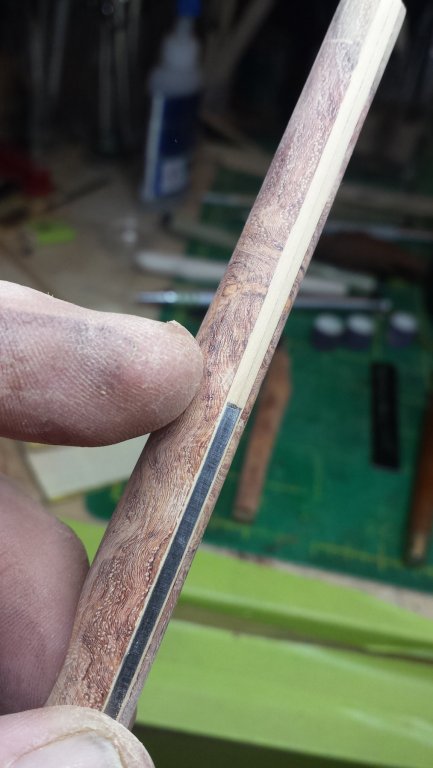
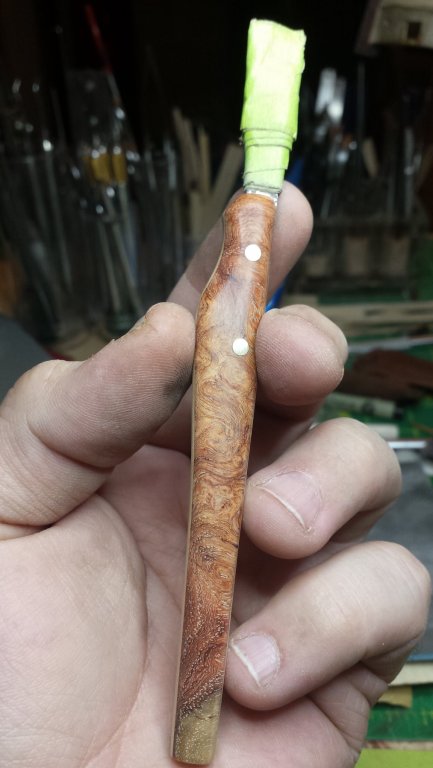
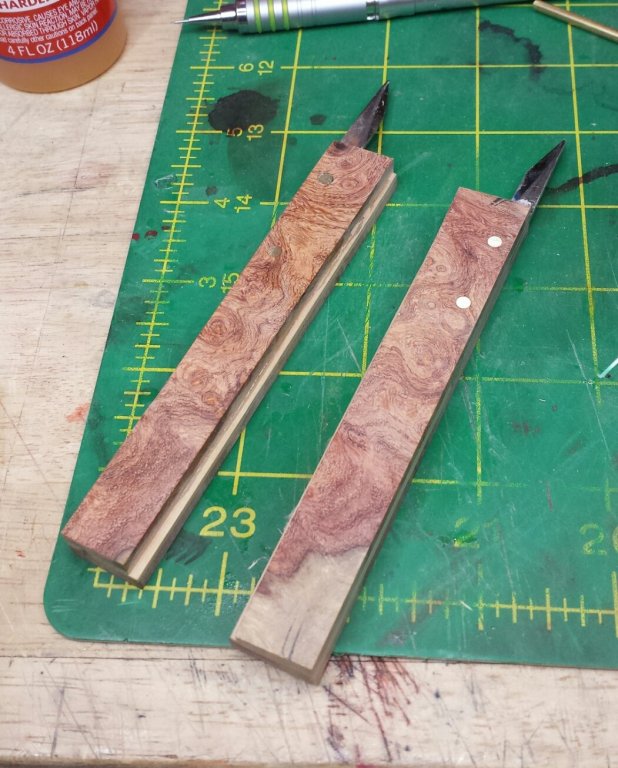
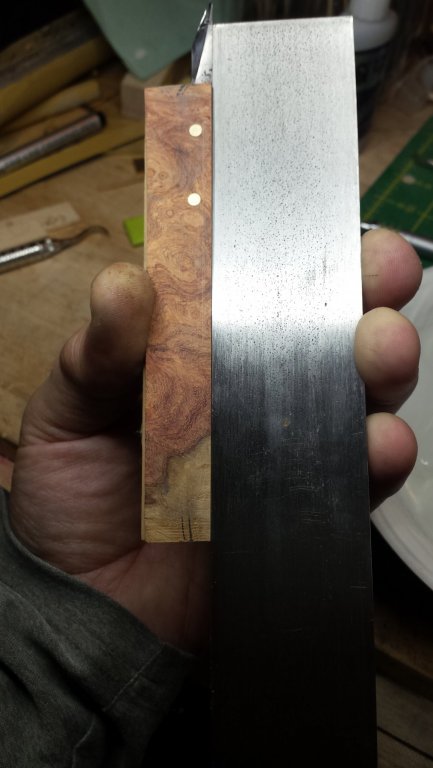
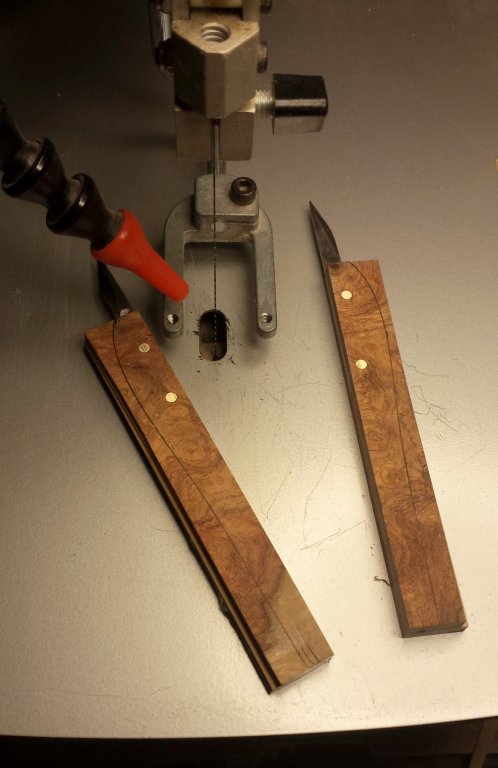
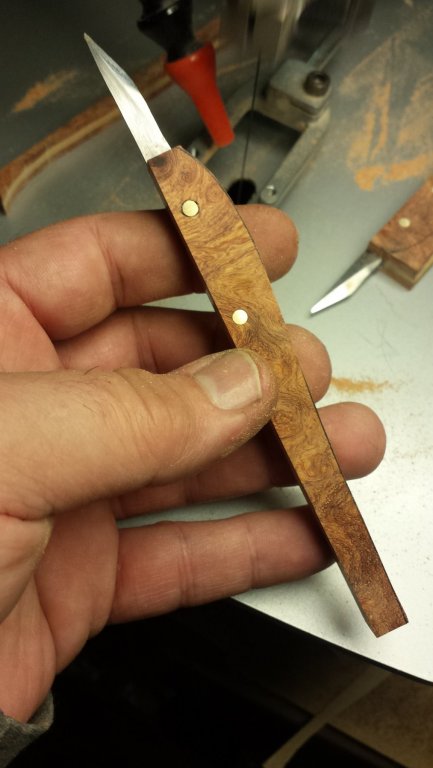
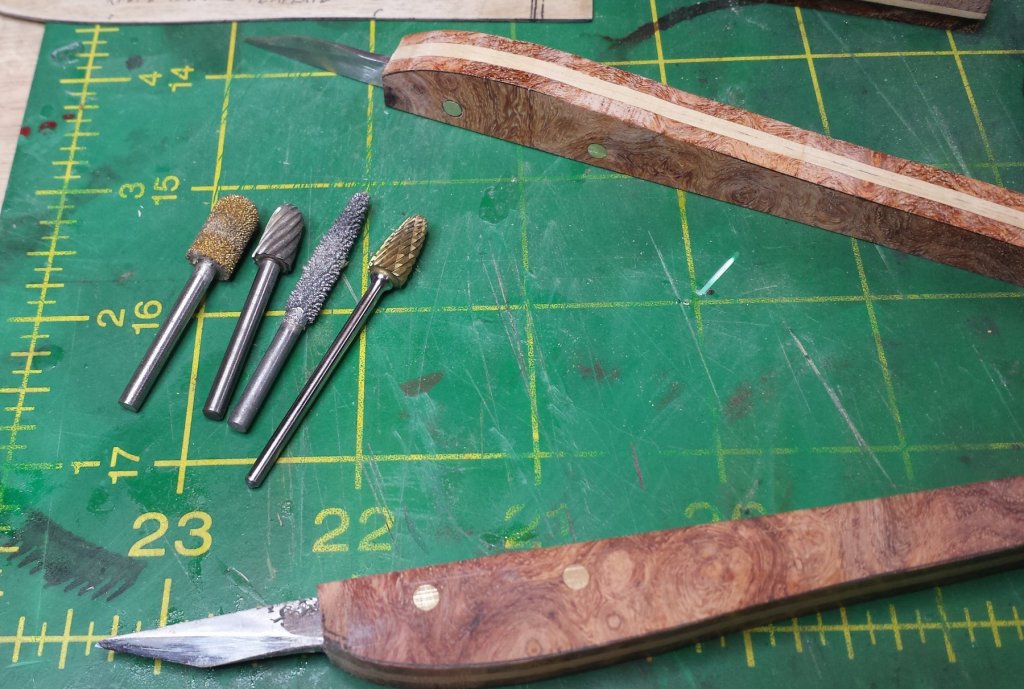
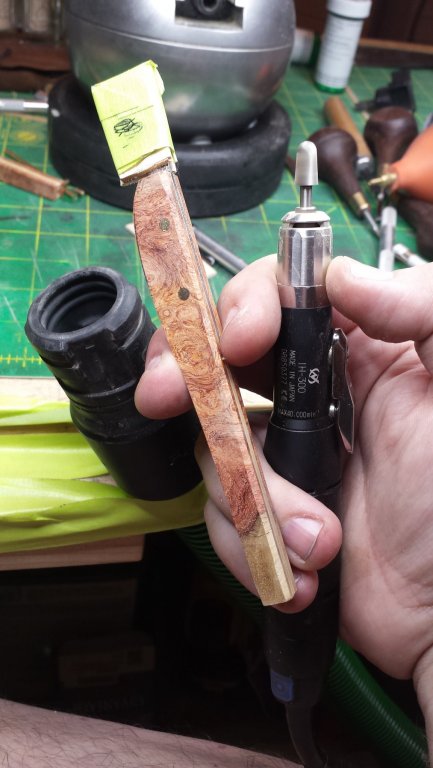
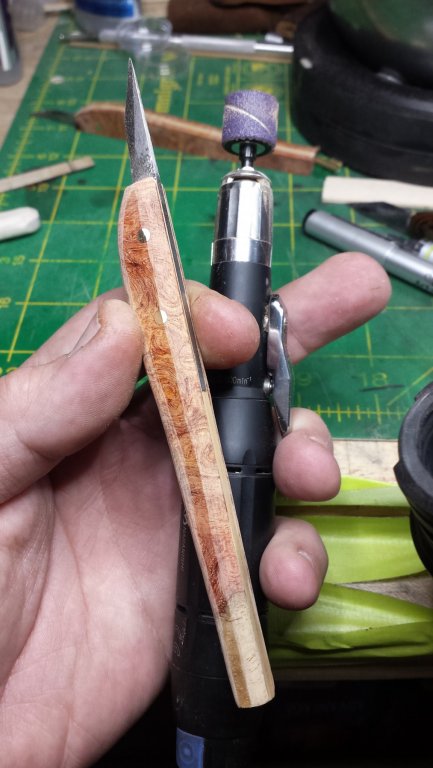
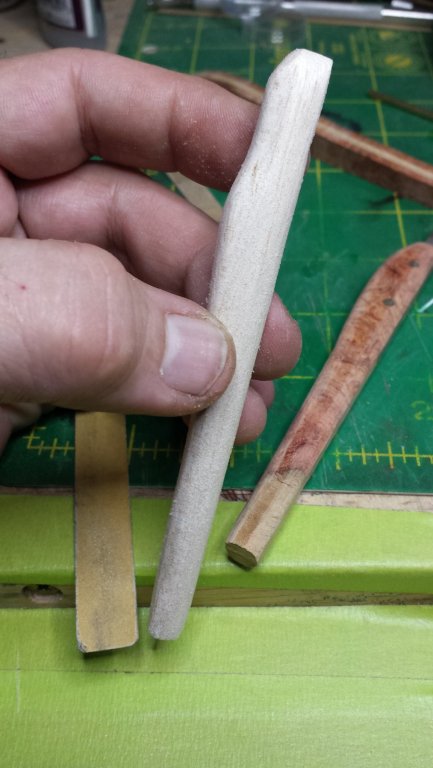
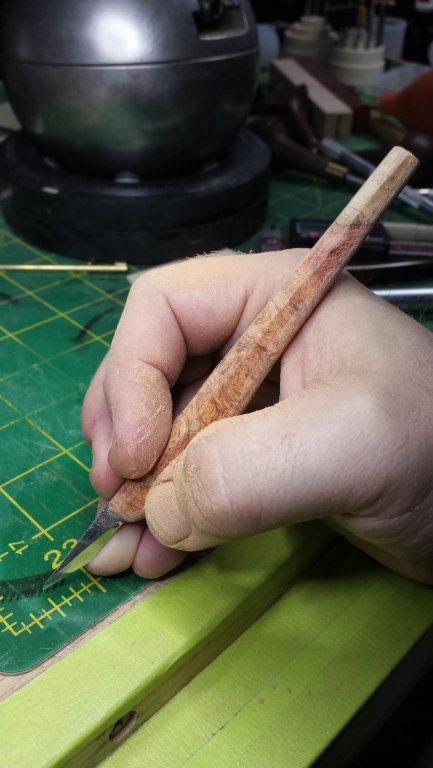
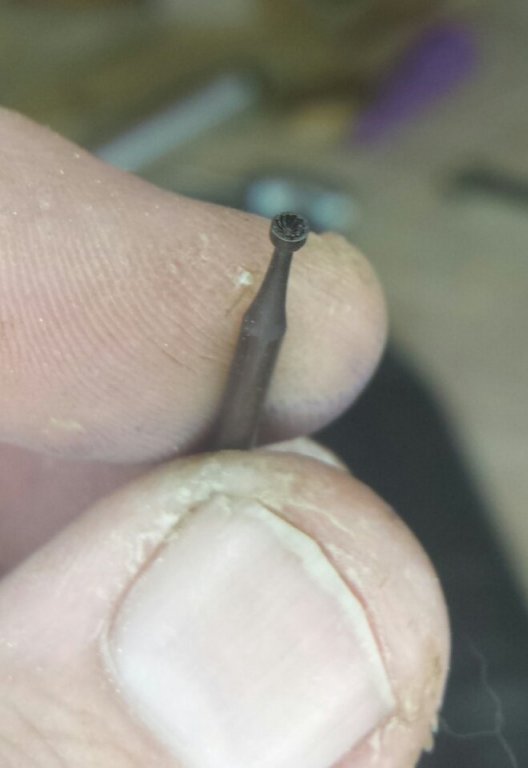
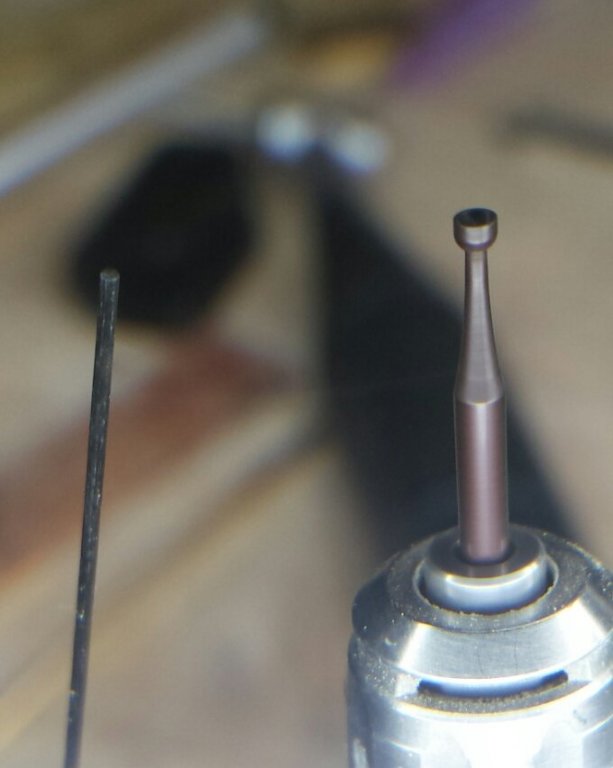
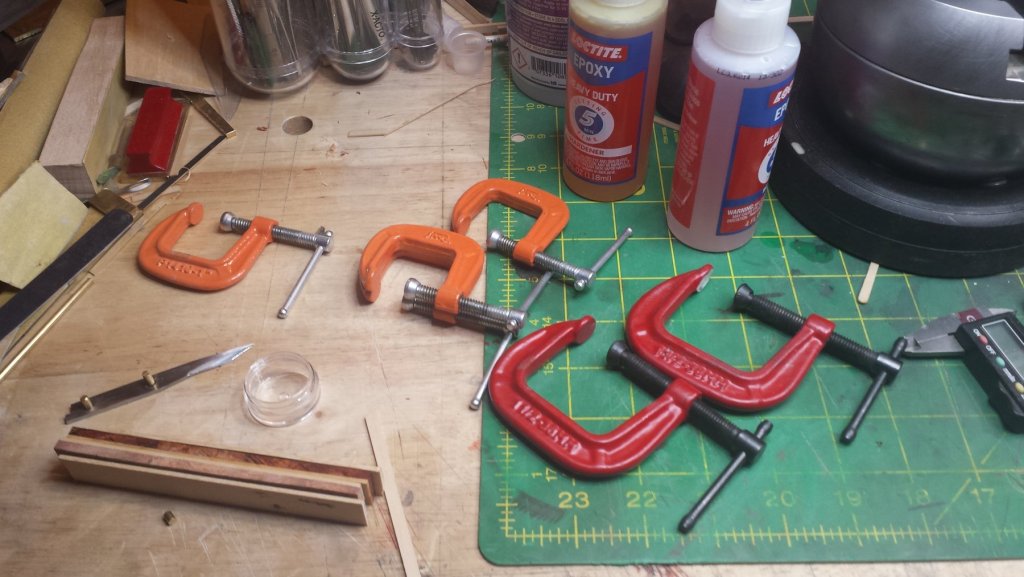
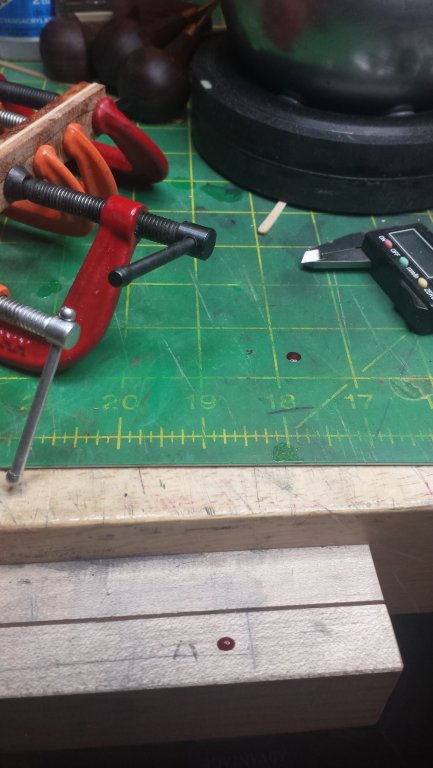
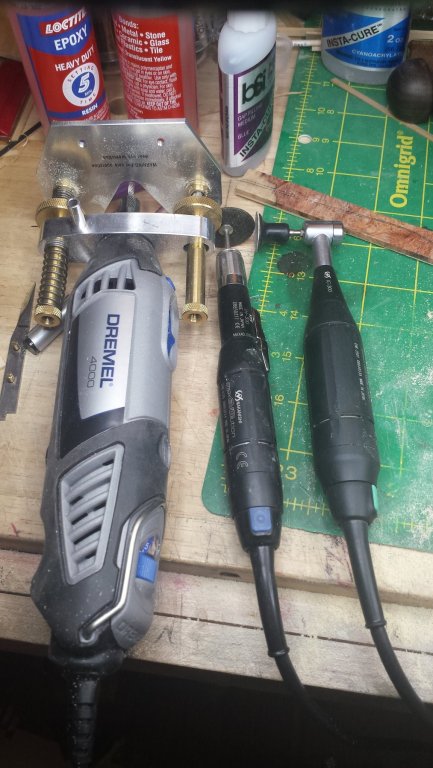
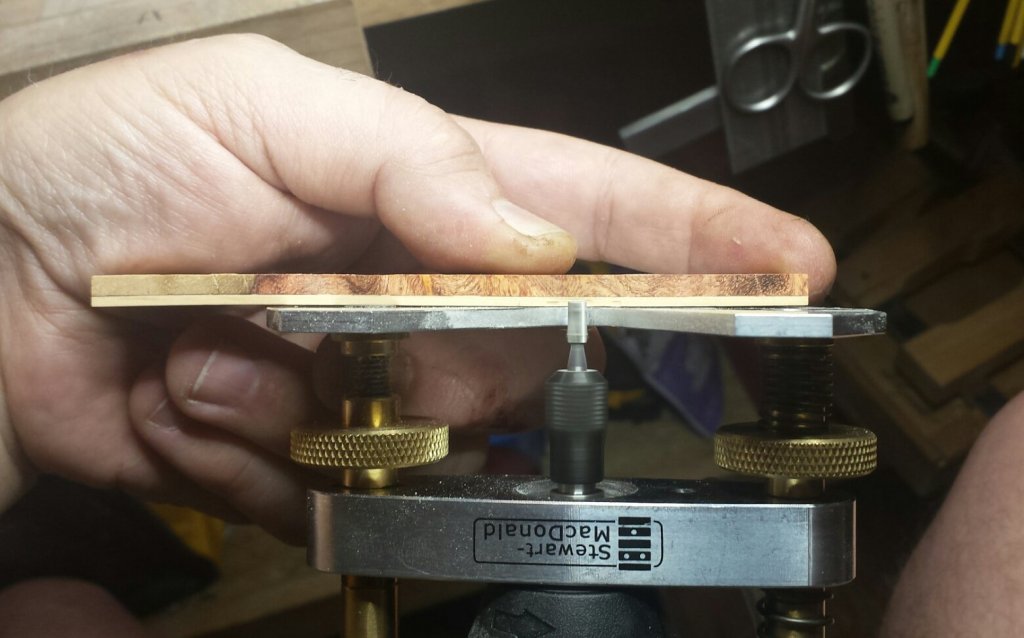
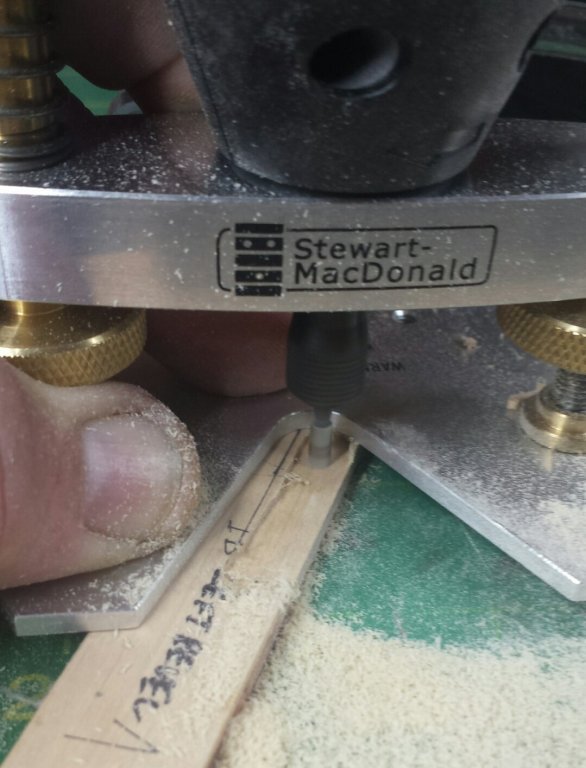
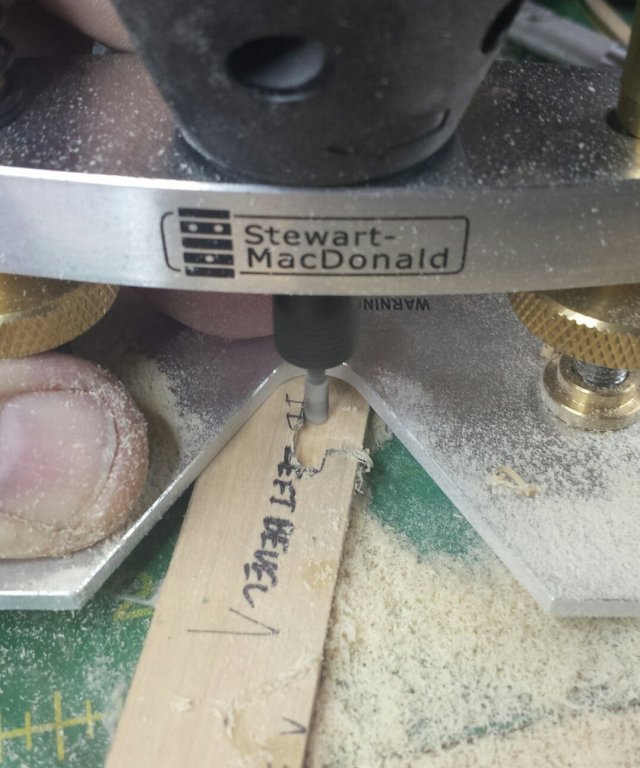
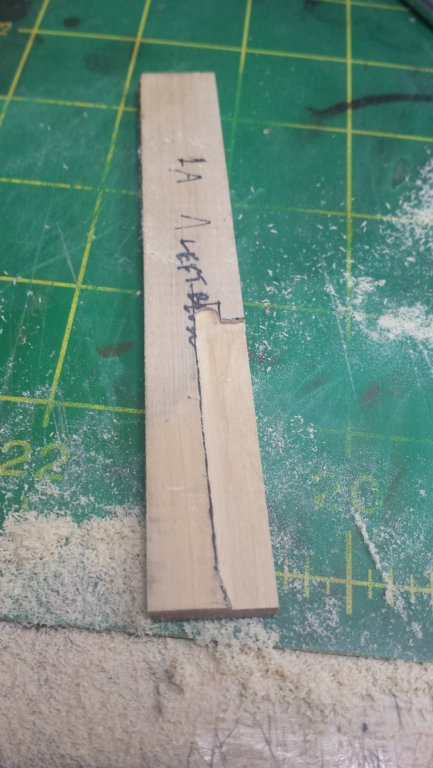
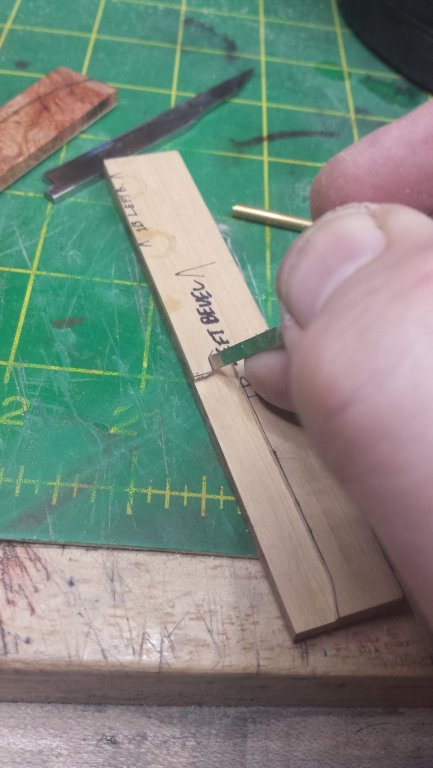
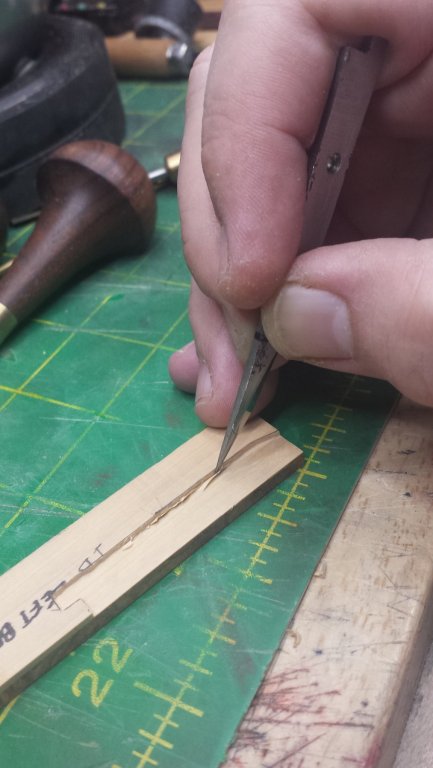
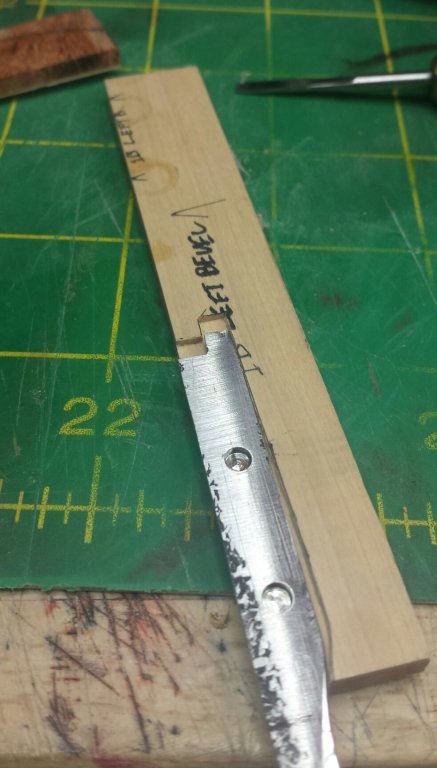
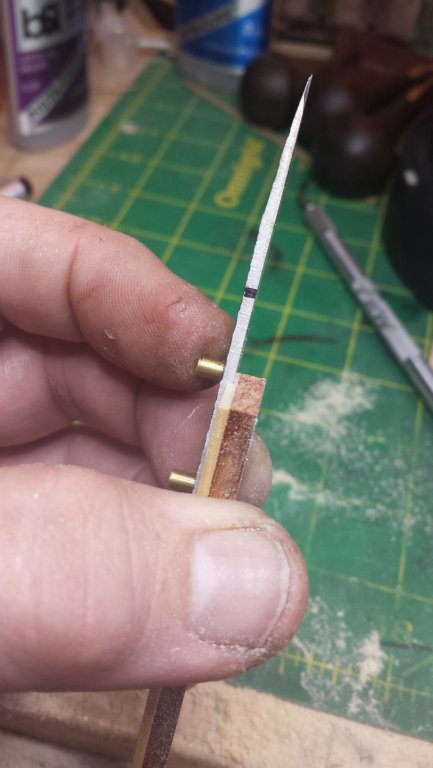
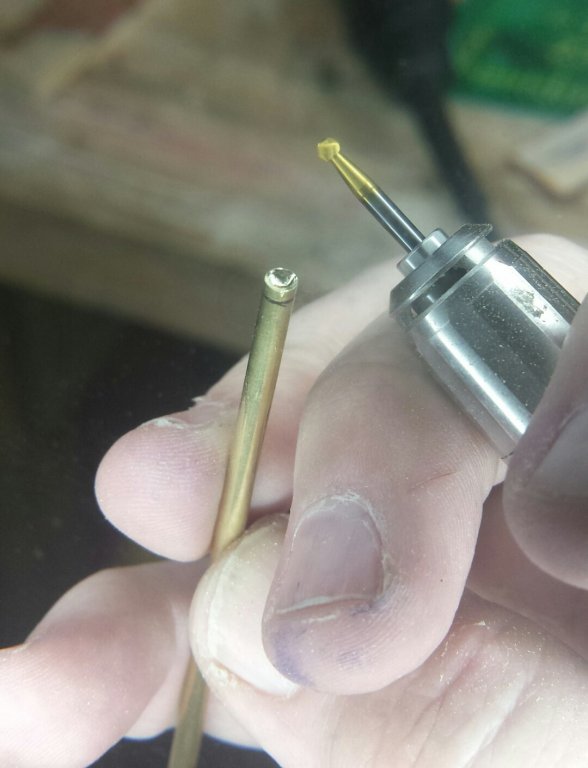
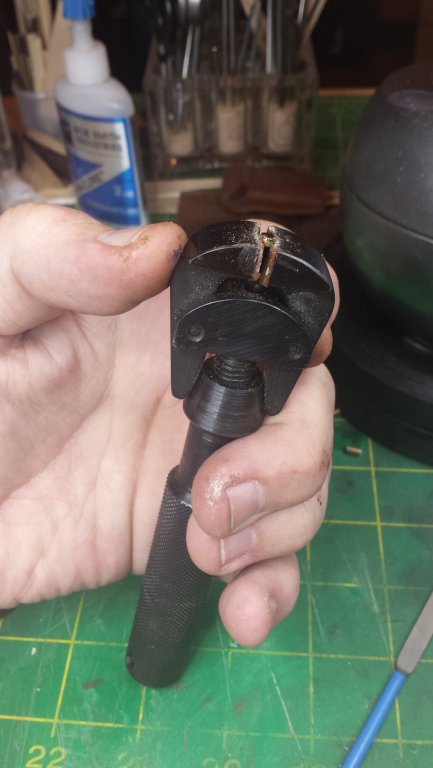
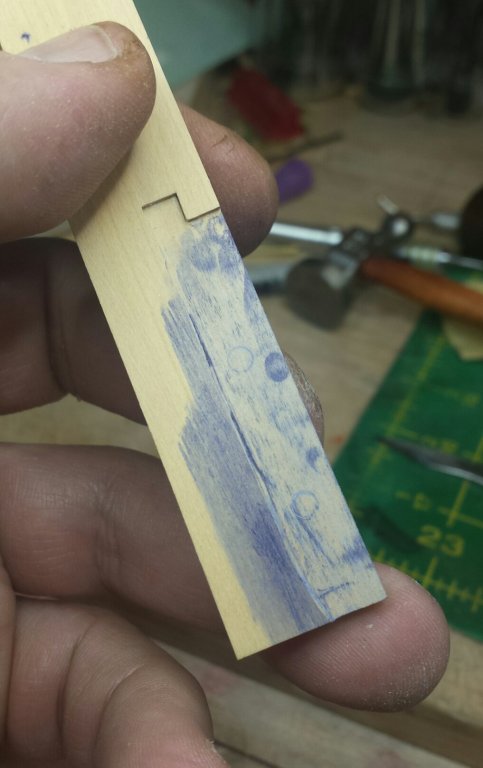
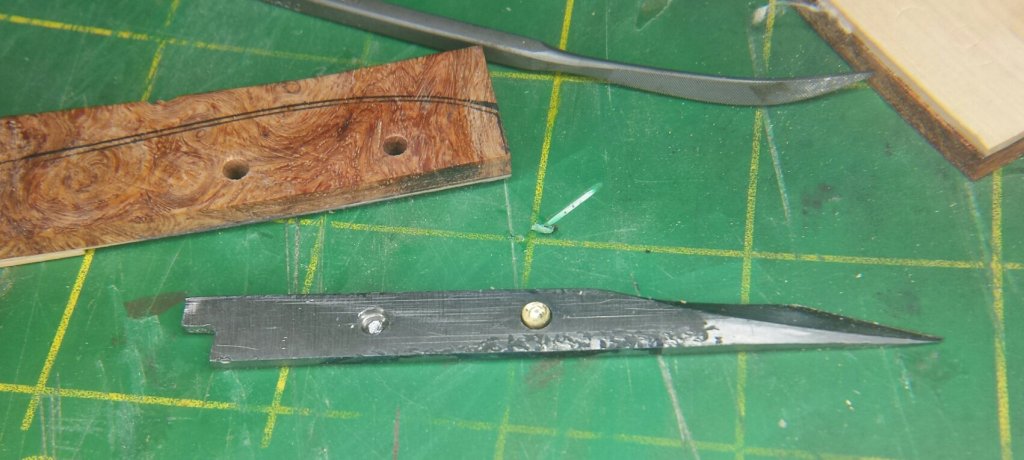
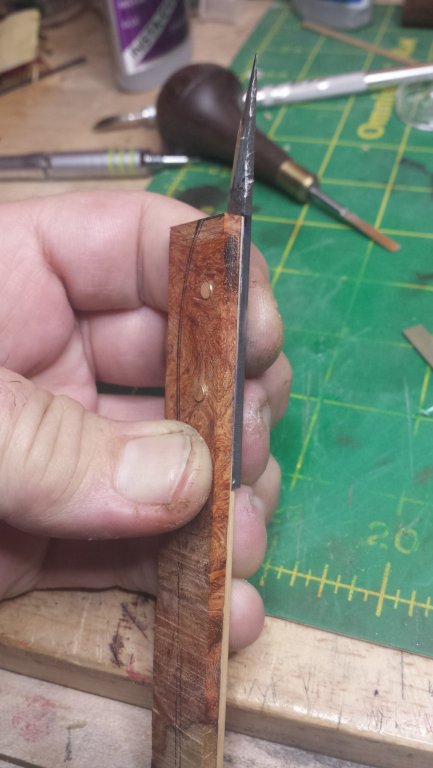
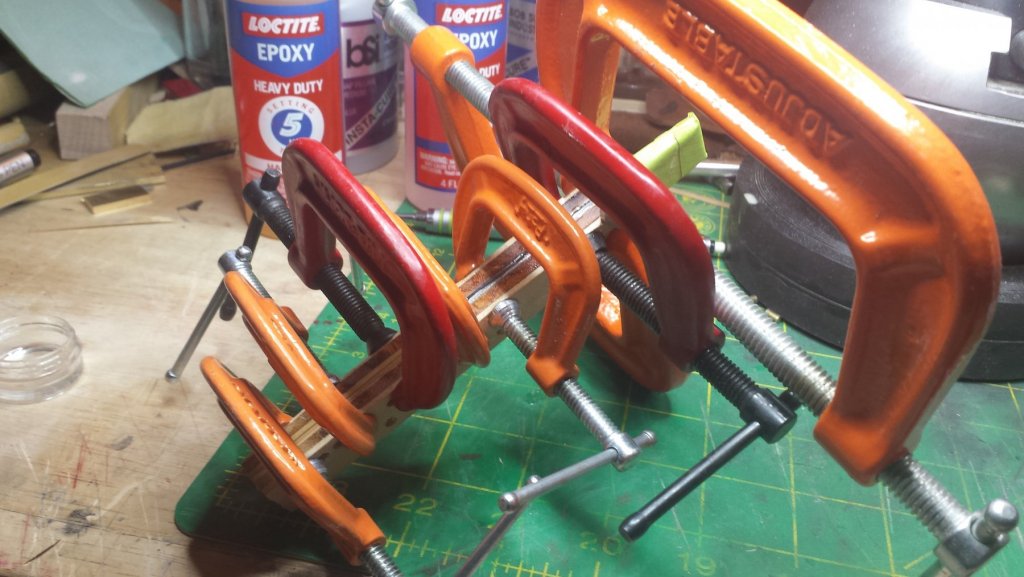
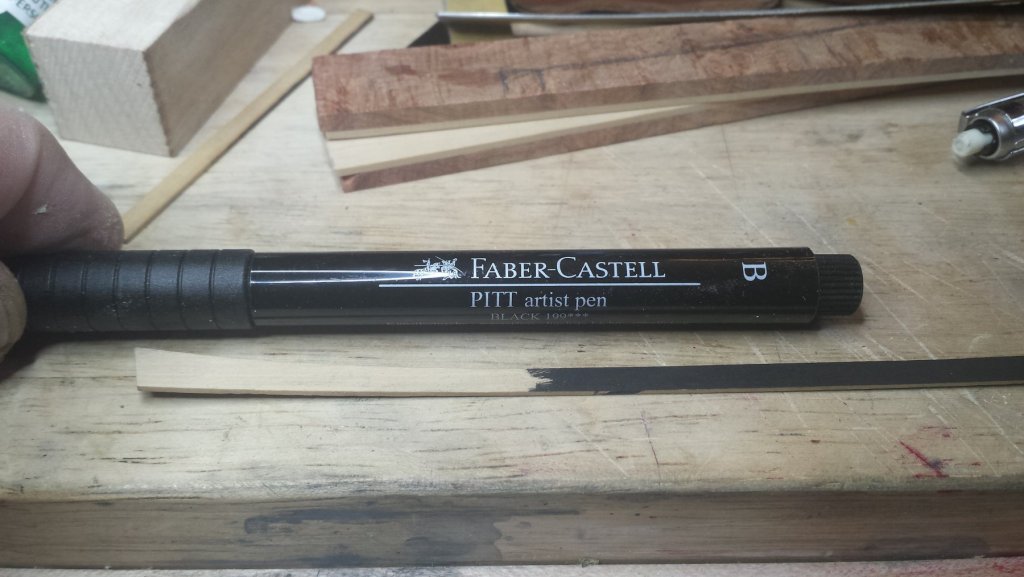
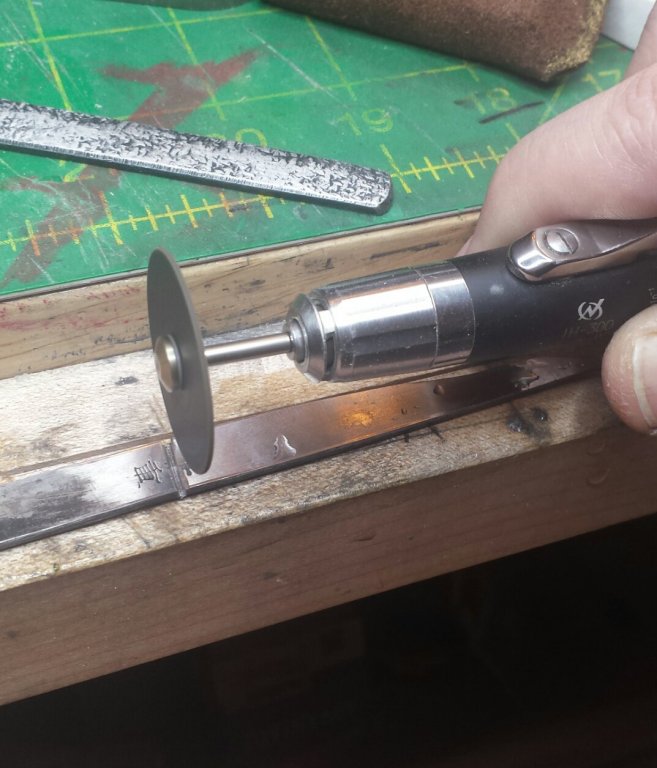
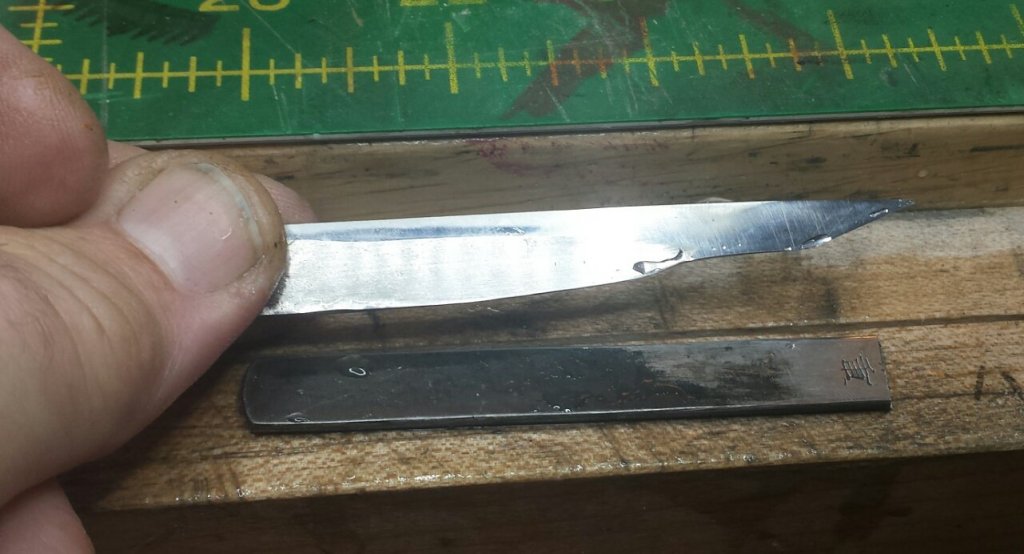
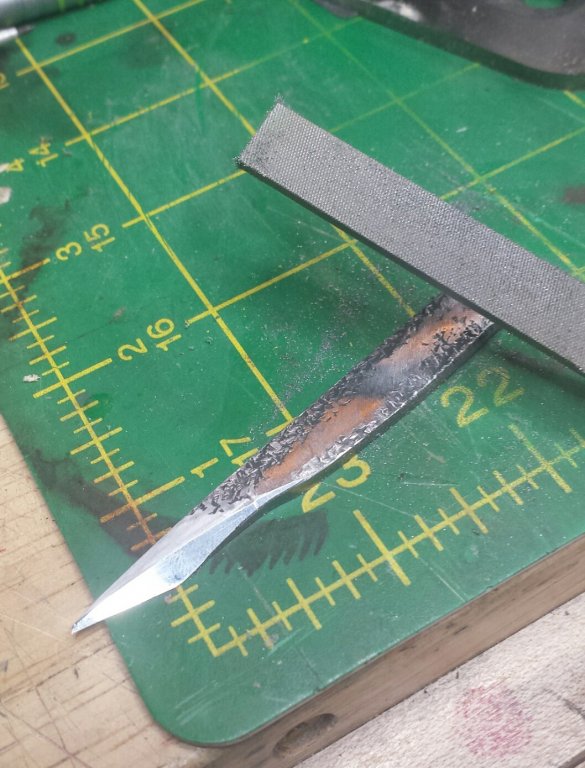
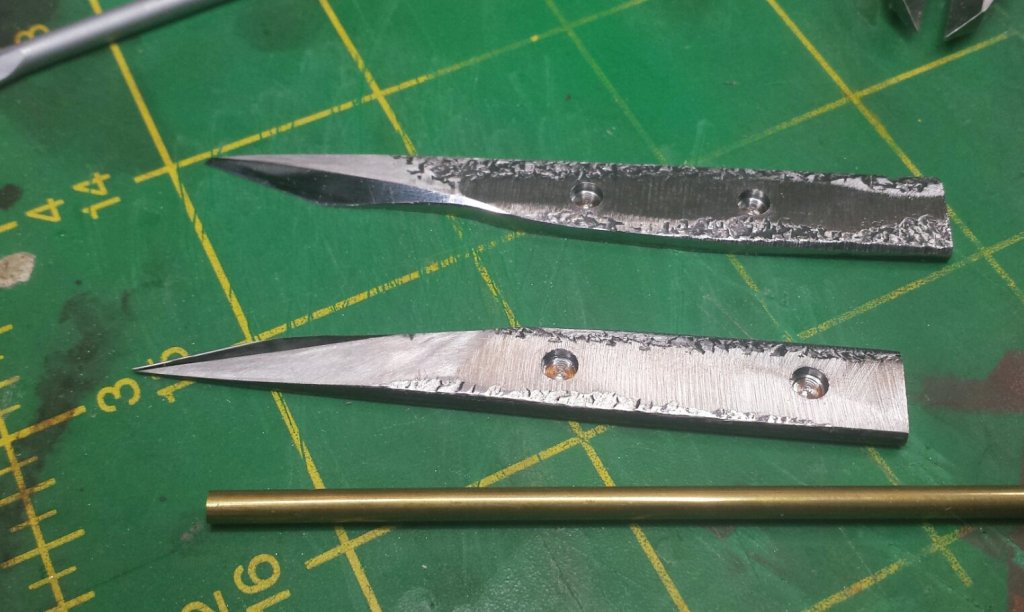
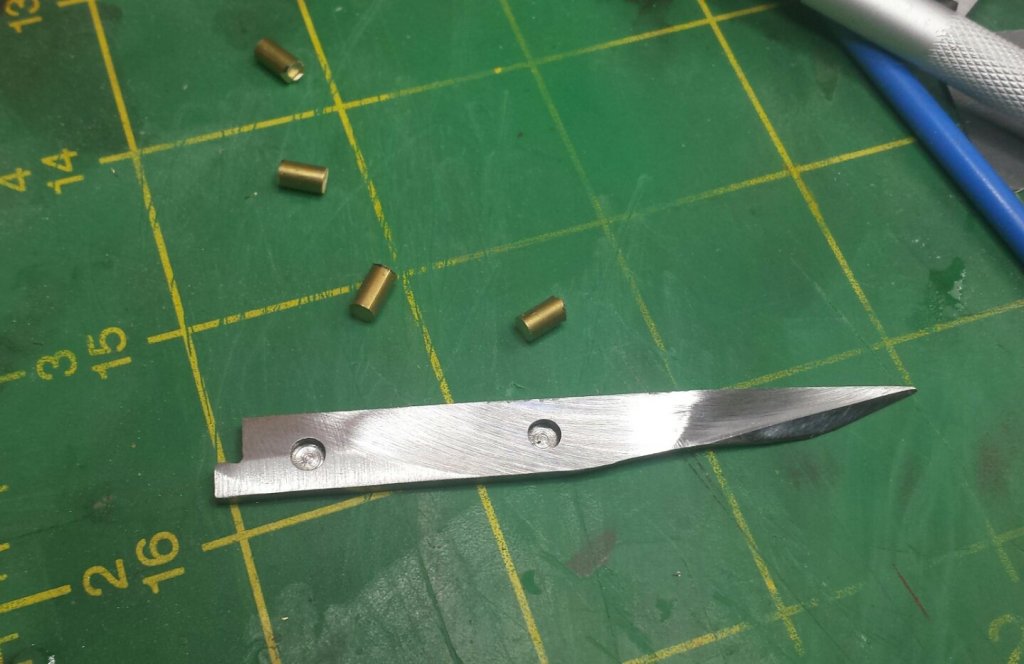
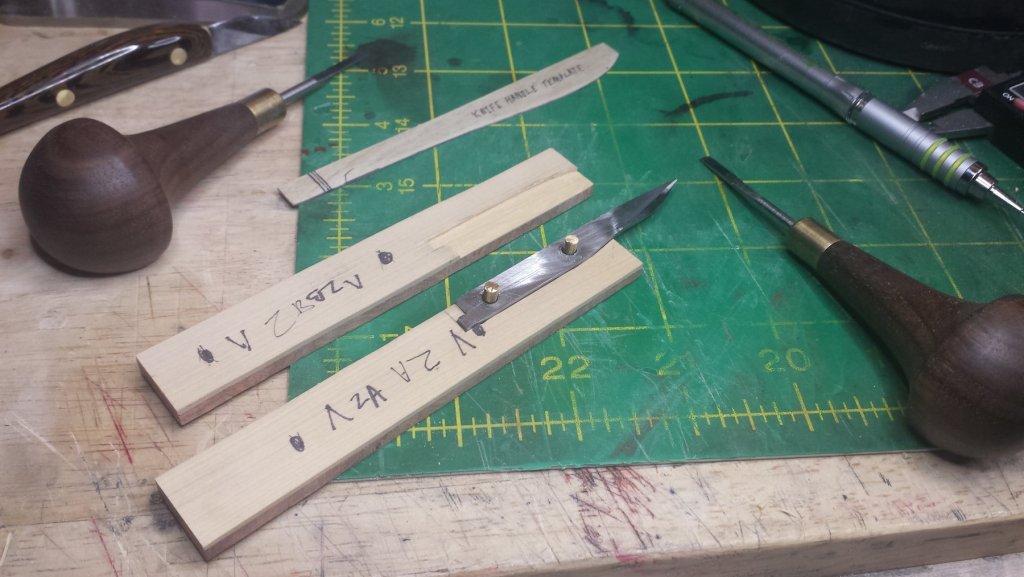
Lady Nelson by vossiewulf - Amati/Victory Models - 1:64
in - Kit build logs for subjects built from 1801 - 1850
Posted
Both Popeye and Rick were ahead of us already Popeye's point about some of them being good paint applicators and some leaving bubbles is worth remembering, and it might make a difference depending on the viscosity of the paint/ink. So my purchase of the 100 cheaper ones may not have been a great idea.
Popeye's point about some of them being good paint applicators and some leaving bubbles is worth remembering, and it might make a difference depending on the viscosity of the paint/ink. So my purchase of the 100 cheaper ones may not have been a great idea.
Popeye, I promise to be careful, but remember these are not the first but like the 27th and 28th lethally sharp knives I own I also prefer it when they bite you a little early, the ones that make me nervous are the ones that are saving it up for one big shot.
I also prefer it when they bite you a little early, the ones that make me nervous are the ones that are saving it up for one big shot.
Thanks Sam. Yes a transfer punch would have worked great had the holes in the blade gone all the way through as they usually do, that would be the right way to mark the hole locations on the handles for a normal blade. But here they only went 3/4 through as I drilled them but didn't have anything that could have drilled through the Rc63 layer on the back side of each blade, so I had to get creative to figure out a way to transfer them.
What I should have done is been a tad more patient and sent a drawing to Ron Hock as to what I wanted, he does custom work at very reasonable cost. That's what I did for my wenge knife among others, I recall the blade for that knife was just $25 or $30, but I did have to wait a couple weeks. And it was one small blade instead of effectively the two I got out of each of those $22 marking knives. I'd recommend anyone wanting to make knives similar to the above who are not cost-limited to do the same and contact Ron at Hocktools.com with a clear drawing with measurements of what you need, he will quickly respond with a price.
With nice normal through holes, the only tricky part is the rabbets. If you have a mill or a Dremel router base similar to mine, no problem, very easy to do. But you can also do it accurately with a knife and/or paring chisel if you're good with those tools, that's how they used to do it. I should draw something here, there's a three-step process to doing something that like quickly and accurately with a knife, if you follow those steps it really is quite plausible to cut those rabbets well with no power tools.